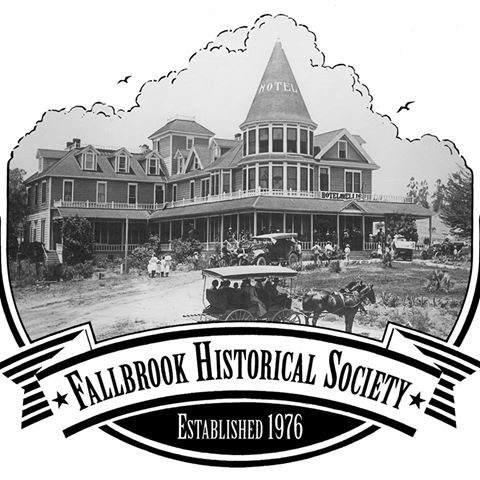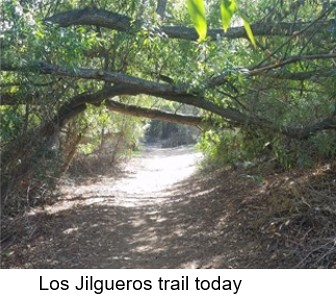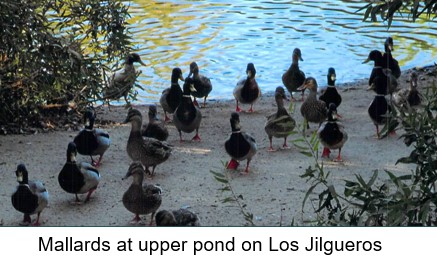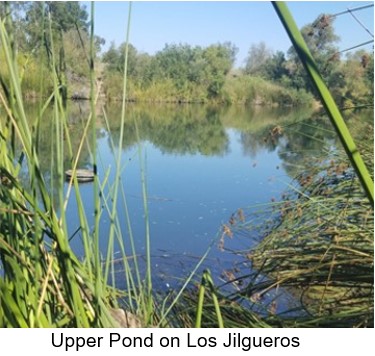The Los Jilgueros Preserve along South Mission Road gets its name from an 1889 map that identifies the stream as the Arroyo de Los Jilgueros.[1] Jilgueros is Spanish for finches, a bird that is abundant here. The arroyo runs between the low rolling hills that it drains.
The original inhabitants of this land were the Luiseno Indians. Metates, or stone grinding tools, were once found along here and it is thought that many still remain buried in sediment.[2]
After secularization of the Spanish Mission lands, California Governor Pio Pico claimed the Los Jilgueros area as part of his Rancho Santa Margarita Grant in 1841. However, the American survey of 1870 moved the Rancho boundary west by several thousand yards. This opened up a space that became available for homesteading, leading to the settlement of the future Fallbrook.
Benjamin Neff’s family came from Sacramento and homesteaded at Los Jilgueros in 1882. Neff’s son, Ben Neff Jr. became publisher of Fallbrook’s first newspaper, the Fallbrook Review in 1885.[3] Ben’s younger brother Millard Neff was a leading merchant and civic leader in the new town of West Fallbrook. Their sister Harriett Neff married A.J. Foss, a pioneer rancher of San Luis Rey since 1870.

Los Jilgueros Creek crossed the Neff homestead (see map) which was useful for irrigating their garden and citrus orchards.[4] Years later, as the Neff family began to move on, the homestead was gradually sold off in parcels.
Ben Neff married and planned to move his family to San Diego. Millard Neff sold 20 acres of his land west of the creek in 1887, at an attractive price to persuade G.F. Van Velzer to come to Fallbrook and succeed his brother Ben with printing the Fallbrook Review newspaper. The Reverend William Pittenger bought 20 acres next to Van Velzer in 1890. The original Pittenger house is still standing where the Fallbrook Historical Society is located today. William Ellis bought 40 acres adjoining his ranch that was partly located where Fallbrook High School is today. William Ellis’ sons called Los Jilgueros “Coyote Creek” as there were so many coyotes seen along the creek bed.
In 1922, after a careful search around the County for the right planting soil, Arthur Anthony from Illinois bought 20 acres from William Ellis.[5] The following year, Arthur Anthony built a home on his Anthony Ranch. Anthony planted avocados and gradually expanded his property holdings to 160 acres. Over the years Arthur Anthony became a widely recognized leader in avocado growing and water management techniques.
It wasn’t easy. Anthony’s wells would dry up in Fallbrook’s summers. Then during the rainy season, run off water from surrounding hillsides, partly caused by the dry farming methods typically used in Fallbrook’s early days, rushed down cutting deep ravines across Anthony’s land. The run off water quickly did its damage and was gone, racing with the flooded San Luis Rey River towards the Pacific Ocean.
Following the winter of 1930, Anthony decided to do something about the problem. Using a Fresno Scraper pulled by a horse team, Anthony dug a series of earthen check dams, one below the other until he had 100-acre feet of water stored. These small reservoirs were successful in recharging his wells that fed the irrigation system he installed.[6]
Gophers dug thru the earthen dams, weakening them. In 1937, when he could afford it, Anthony used concrete to reinforce his dams. By the 1940s, Anthony’s shimmering ponds visible from Mission Road were a landmark of Fallbrook. With plenty of water all summer and utilizing moisture saving mulch that he grew, just 25 acres of Anthony’s trees were producing 125 to 200 tons of avocados a year.[7]
Anthony’s methods were a revelation to other Fallbrook and regional farmers. His orchards became a showcase which he frequently gave tours of to other farmers and agriculture students.
In 1938 Arthur Anthony became a founder and an elected director of the Fallbrook Soil Conservation District [8] to assist farmers with soil erosion and mitigation. Later the Fallbrook district evolved into the Middle San Luis Rey Soil Conservation District to include Bonsall and Rainbow. Arthur Anthony served as the district president. Today this is known as the Mission Resource Conservation District, with headquarters on Alvarado Street in Fallbrook.
After Arthur Anthony died in 1959 at the age of 88, his son Donald took over the ranch. When Donald Anthony died 25 years later in 1984, the land fell into disuse. To protect the open space, the Fallbrook Land Conservancy obtained the property in 1990 through a donation by the family of Pamela Van Der Linden.[9] The Fallbrook Land Conservancy’s first acquisition, Los Jilgueros Preserve was opened to the public on Earth Day in April 1990.
Various farm equipment from the Anthony Ranch still stand in the Los Jilqueros Preserve exactly where they were abandoned when the ranch ceased operations. Remnants of Arthur Anthony’s concrete check dams, now overgrown with vines and trees, are visible to hikers in the Preserve. A large upper pond formed by Anthony’s conservation efforts still remains. In addition to waterfowl, the pond is used to this day by Cal Fire to fill aircraft water tanks for nearby firefighting.
Footnotes:
1 Fallbrook Enterprise March 16, 1990. Fallbrook Land Conservancy. See map excerpt above.
2 Bill Anthony, Arthur Anthony’s grandson, interviewed by Shogo Yamaguchi Dec 8, 2012
3 1st issue of 1885 Fallbrook Review and homesteading records at Fallbrook Historical Society.
4 Fallbrook in Review, vol. 4 pg. 67, Pittenger Farm House by Don Rivers.
5 Fallbrook Enterprise, August 24, 1923.
6 California Farmer, Feb 13, 1940 pg. 173; For Avocados, Ask Anthony by Joe Crosby
7 ibid
8 Fallbrook Enterprise, Oct 7, 1938
9 Wallace Tucker, Fallbrook Land Conservancy










